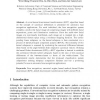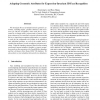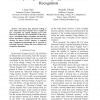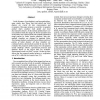ACCV
2007
Springer
14 years 7 months ago
2007
Springer
A novel kernel discriminant transformation (KDT) algorithm based on the concept of canonical differences is presented for automatic face recognition applications. For each individu...
WACV
2007
IEEE
14 years 7 months ago
2007
IEEE
Single-camera face recognition has severe limitations when the subject is not cooperative, or there are pose changes and different illumination conditions. Face recognition using ...
SMI
2007
IEEE
14 years 7 months ago
2007
IEEE
We investigate the use of multiple intrinsic geometric attributes, including angles, geodesic distances, and curvatures, for 3D face recognition, where each face is represented by...
IEEEICCI
2007
IEEE
14 years 7 months ago
2007
IEEE
— The theory that Electoral College is more stable than Direct Popular Vote is applied in face recognition. By simplly adopting most traditional PCA approach, the experiments in ...
ICIP
2007
IEEE
14 years 7 months ago
2007
IEEE
In our previous work we presented a new 2D-3D mixed face recognition scheme called Partial Principal Component Analysis (P2 CA) [1]. The main contribution of P2 CA is that it uses...
ICCV
2007
IEEE
14 years 7 months ago
2007
IEEE
In the literature of psychophysics and neurophysiology, many studies have shown that both global and local features are crucial for face representation and recognition. This paper...
CVPR
2007
IEEE
14 years 7 months ago
2007
IEEE
In building a face recognition system for real-life scenarios, one usually faces the problem that is the selection of a feature-space and preprocessing methods such as alignment u...
CVPR
2007
IEEE
14 years 7 months ago
2007
IEEE
In this paper, we propose a novel learned visual codebook (LVC) for 3D face recognition. In our method, we first extract intrinsic discriminative information embedded in 3D faces...
AVSS
2007
IEEE
14 years 7 months ago
2007
IEEE
The ever growing need for improved security, surveillance and identity protection, calls for the creation of evermore reliable and robust face recognition technology that is scala...
ACIVS
2008
Springer
14 years 7 months ago
2008
Springer
Several applications such as access control, behaviour observation and videoconferencing require a real-time method for face recognition. We propose to represent faces with parabol...




